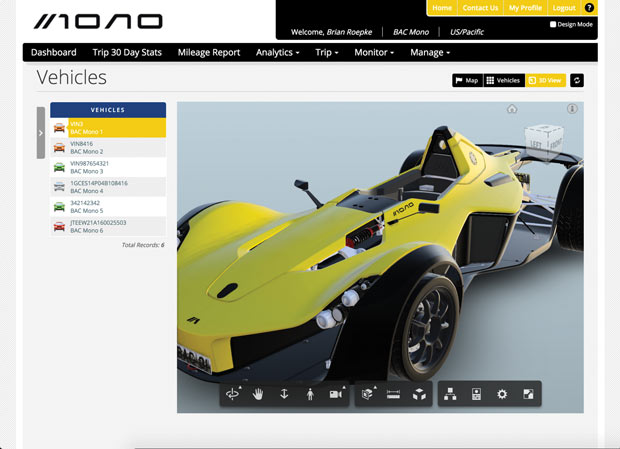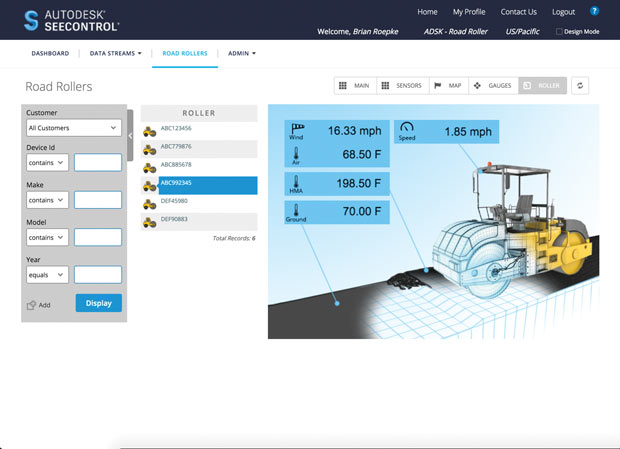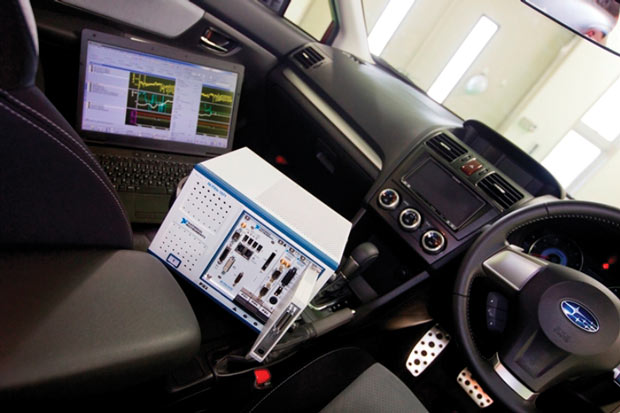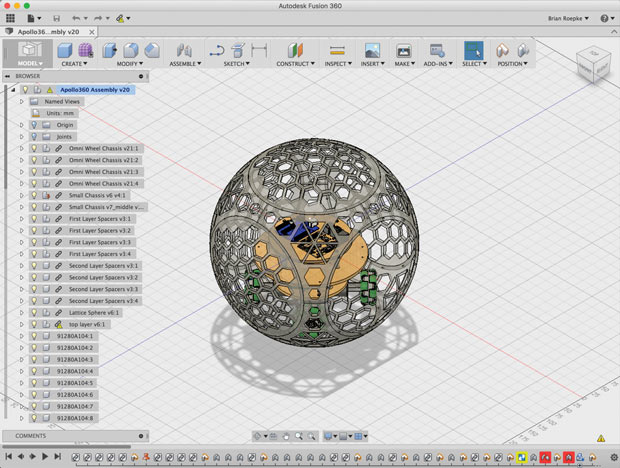Seeing Digital Twin Double

Sportscar maker Briggs Automotive uses Autodesk to create virtual models of its custom vehicles. Image courtesy of Autodesk.
Latest News
January 29, 2016
 Sportscar maker Briggs Automotive uses Autodesk to create virtual models of its custom vehicles. Image courtesy of Autodesk.
Sportscar maker Briggs Automotive uses Autodesk to create virtual models of its custom vehicles. Image courtesy of Autodesk.
The line between virtual simulation and real-world testing is beginning to blur thanks to the Internet of Things (IoT), augmented and virtual reality technologies, reality capture, generative design software and advanced simulation technologies. By combining these capabilities, engineering software vendors are enabling the concept of the digital twin and taking simulation and testing in an entirely new direction.
A digital twin is a virtual or digital representation of a physical machine, vehicle, building or other object. “It’s a model that uniquely represents a physical occurrence in the real world,” says Mike Campbell, executive vice president, Digital Twin, at PTC. “This one-to-one mapping is important. You create a relationship between the digital data and a unique product occurrence from a variety of sources: sensors, enterprise data on how it was made, what its configuration was, its geometry, how it is being used, and how it is being serviced.”
With the explosion in sensor-laden smart devices that have emerged under the umbrella of the Internet of Things, it is possible to “simulate” an existing physical product by using sensors and other technology to link the real object and the digital model.
The resulting avatars can be used to virtually test a system prior to physical validation, provide feedback for iterative design activities, and potentially improve service and maintenance operations. “We see a lot of interest in this digital twin idea coming from automotive, aerospace and defense, and machinery, yet we also hear some of our mid-market customers, such as Tier 1 suppliers, line builders and even job shops, talk about how the digital twin will help them become more productive,” says Zvi Feuer, senior vice president of Manufacturing Engineering Software at Siemens PLM Software.
According to Brian Roepke, senior director for IoT and PLM at Autodesk, the primary markets for the technology so far include industrial machinery and specialty vehicle OEMs (original equipment manufacturers), but “there isn’t a maker of a physical thing out there who isn’t in some way or another considering it,” he says.
 Autodesk SeeControl allows users to build a data model of a physical object. Image courtesy of Autodesk.
Autodesk SeeControl allows users to build a data model of a physical object. Image courtesy of Autodesk.
The potential utility of a digital twin goes far beyond just the simulation and testing of new products. Smart systems that are meant to adapt to different environments or operating conditions. “For example, the automotive industry is doing a lot of investigation on developing self-driving cars. First of all, it will be a challenge to design those as a complex mechatronic system. But after development, the self-driving vehicle will need to interact with external systems that can change over time,” says Jan Leuridan, senior vice president of Simulation and Test Solutions at Siemens PLM Software. “Manufacturers who want to manage this need digital twins to manage the entire lifecycle of such products.”
Blurring the Lines Between Reality and Simulation
Exactly how the software vendors operating in this space define digital twin can vary. According to Siemens’ Feuer, the digital twin is a full-scale virtual model of the product as it matures during the design lifecycle. “For the end user, this digital twin will provide the opportunity to evaluate the product by looking at its shape, fit and function, and analyzing some of its main features under different operational constraints,” he says.
In some cases, this includes the ability to generate 3D models of multi-physical systems that can be run through simulations in advance of production. In others, a physical object is outfitted with sensors to provide data that is overlaid on a 3D model. Unlike a model used in virtual simulations or prototyping, in this case the model would not be a general representation of a product, but a digital avatar of a single specific item.
National Instruments doesn’t use the term digital twin, but its hardware-in-the-loop (HIL) testing technology platform provides similar functionality for complex automotive and aerospace applications. HIL combines physical testing and simulation to ensure that systems will behave as expected prior to actual field testing.
 National Instruments’ hardware-in-the-loop technology combines physical testing and simulation to ensure that systems will behave as expected prior to actual field testing. Image courtesy of National Instruments.
National Instruments’ hardware-in-the-loop technology combines physical testing and simulation to ensure that systems will behave as expected prior to actual field testing. Image courtesy of National Instruments.
“For an automotive or aerospace OEM, if you take all of these components out on the road not knowing if they work correctly and try to do physical testing, it can be expensive and dangerous if something goes wrong,” says Noah Reding, principal product manager at National Instruments. “It can also delay the release of the product. With HIL, you can simulate the entire world around these different components and give it a level of validation before it goes into the field.”
Subaru used HIL testing for its motor electronic control unit (ECU) in its first production model hybrid vehicle, the XV Crosstrek. The company built a verification system using the NI FlexRIO platform to replicate severe testing environments that could not be replicated on a physical test track. Engineers connected the ECU to a real-time electric motor simulation. The system included FlexRIO FPGA modules that executed a model representing the simulated operation of the motors. It was deployed using NI LabVIEW system design software.
PTC has made digital twin technology a priority with its ThingWorx IoT platform. “Design and engineering teams suffer from a lack of understanding about what is happening with products in the real world,” Campbell says. “We can simulate how we think a pump will be used, but most manufacturers don’t really have any idea until something goes wrong.”
With digital twins, engineers can access real-world performance data from a whole collection of unique product instances, and use that to inform their designs. “That’s hard insight to get today,” Campbell says. “In a digital twin environment, that’s a benefit they would get that would allow them to make better products.”
The Autodesk SeeControl platform allows users to build a data model of a physical object. Autodesk can also use live sensor data that can be attributed directly on the object representing the sensor on a 3D model.
“Users can walk through a machine or complex product and really investigate what is happening with it, and to it,” Roepke says. “Many of us are visually inclined, so this is what we think of as the ultimate digital twin for the engineer. It helps quickly spot trends and patterns in how a machine performs.”
At Siemens PLM Software, the digital twin is built in Teamcenter using NX CAD, NX CAE and the LMS portfolio for simulation. The company’s new Polarion solutions support development of embedded software. Teamcenter Manufacturing and Manufacturing Engineering solutions are used to build the digital twin of the actual production system that will be used to produce the product.
Improving Design and Service
There are already a number of practical applications of digital twins emerging in different industries. A designer can bring live operational data into the digital model to help make better decisions while creating next-generation products, similar to the way a Web designer uses analytics to adjust the webpage UI (user interface) based on actual user experience patterns.
“By utilizing real world performance information, an engineer can optimize his or her designs based on how a product was actually used as opposed to the documented requirements that were assumed when the design first happened,” Roepke says. “Most product engineers never get to see how their creations operate in the real world in real time—if at all.”
The technology can also be used to accelerate and improve iterative design. For example, Autodesk and media company Bandito Brothers collaborated on the Hack Rod, which used artificial intelligence, sensors and machine learning to design a “perfect” car. The project leveraged Autodesk’s reality capture technology, gathering data from laser scanning, photography and sensors to build 3D models. The team used a prototype vehicle chassis to gather data about the forces on the chassis, and then plugged that into the Autodesk Dreamcatcher design software. Dreamcatcher then generated a design for the new chassis based on that data.
Service and maintenance also stand to gain from digital twins. Transition Technologies recently demonstrated a solution that combines PTC Windchill PDMLink, PTC Servigistics, ThingWorx and the Vuforia augmented reality platform PTC recently acquired. The system combines CAD, PLM (product lifecycle management) and SLM (service lifecycle management) data with the ThingWorx IoT platform. Vuforia then visualizes the technical and service information using live sensor readings. It’s a service application that provides detailed MRO steps and real-time feedback from the device itself during the repair.
A New Approach to Simulation
Digital twins represent a new and more efficient way to test products. Siemens’ Leuridan says that in industries such as automotive, digital twins enable time and resource optimization when it comes to testing. “For design engineers, it implies that they will have to collaborate much more across multiple applications and domains, and thus throughout the different stages of the development cycle,” Leuridan says. “Fortunately for them, a common platform will allow them to do so. They will still have their specialization, but they will be able to work with more accurate input, or within more realistic boundary conditions. They will be more effective and also gain more insight into their work considering the bigger picture.”
The technology will also improve traditional simulation by providing real-world data to enhance simulations. “You are simulating the product based on how it is actually being used,” Campbell says. “It adds more value to the whole simulation story.”
Autodesk, for one, plans to surface the data from its SeeControl product into the Fusion 360 CAD/CAM/CAE platform so that users can take real-world performance data and use it in new designs. “Think about the physical forces on construction equipment or maybe the operating temperature in electronics,” Roepke says. “If you knew exactly how hot something ran or the max and average loads of a front loader across all real-world uses globally, how much better would your simulations be?”
 With future integration of SeeControl, Fusion 360 users will be able to make design decisions based on real-world data. Image courtesy of Autodesk.
With future integration of SeeControl, Fusion 360 users will be able to make design decisions based on real-world data. Image courtesy of Autodesk.
National Instruments’ Reding says that there has been interest in the energy industry in this type of simulation for testing smart grid controllers. “Another area is in appliances and white goods,” he adds. “Washers and dryers have embedded control systems. Designers can find defects in the software before it’s deployed, which can save a significant amount of money when it comes to recalls or brand damage. It also provides improvements in development time and reductions in cost.”
Manufacturers can also use these platforms to provide performance data to their own customers as a value-added service. Autodesk is offering SeeControl as a white labeled solution for manufactures that would otherwise have to spend a lot of time and money developing their own platform. “This reduces cost and risk, as well as dramatically decreases the amount of time it takes to get a solution to market—from years to weeks,” Roepke says.
Too Much Data?
Companies utilizing digital twins beyond the testing/simulation phase will face data management challenges as they attempt to turn feedback from products into actionable intelligence for design. “This is truly a Big Data challenge,” Roepke says. “A large piece of industrial mining equipment could generate up to 80GB per machine per day. That starts to stress the edges of networking technology. You start to look at processing that data on the machine instead of sending it all to remote servers to churn through.”
In other cases, though, digital twins would leverage other existing data sources, which would mitigate the data management issue. “Our approach wouldn’t replicate PLM or virtualization or service information,” Campbell says. “You integrate with those systems via ThingWorx, and make the data available again, depending on the various use cases. You shouldn’t think of this as creating a lot of duplicative data that has to be aggregated. The digital twin doesn’t need to include every single piece of data about a product. It just needs to include information that is relevant.”
With major PLM and design software vendors investing heavily in the technology, digital twins—by any name they’re called—will have an impact on simulation and testing. The continued expansion of “smart” products and sensor-laden vehicles and components will make it even easier to create these digital doppelgängers.
More Info:
Subscribe to our FREE magazine, FREE email newsletters or both!
Latest News
About the Author
Brian Albright is the editorial director of Digital Engineering. Contact him at [email protected].
Follow DE





